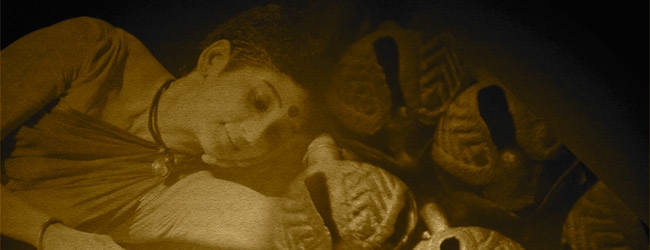CRY JAILOLO
Eko Supriyanto
da:ns festival
Esplanade Theatre Studio/Wednesday
Eko Supriyanto
da:ns festival
Esplanade Theatre Studio/Wednesday
 |
Photo: BERNIE NG, COURTESY OF ESPLANADE - THEATRES ON THE BAY
|
That one movement and the sound that it produced conveyed the idea of an individual that is closely connected to land and sea. He could have been human, fish or even coral.
After a few minutes, two men dressed in the same attire walked onto the stage from opposite sides. They introduced an eerie silence that was in strong contrast to the dancer in the centre who continued with the same movement and sound.
As they moved forward, the foot-tapping became softer. The men stood still. The stern anxiety written on their faces, coupled with the introduction of evocative instrumental music, created a sense of pathos.
Cry Jailolo, a gripping new work by Indonesian choregrapher Eko Supriyanto, highlighted the plight of a small coastal community in Indonesia. Behind the magnificent beauty lies the imminent ruination of Jailolo's coral reefs and marine life by dynamite-fishing practices.
Seven dancers, who belong to various tribes and farming families there, represented their histories, movement practices and contemporary realities in the hour-long work that placed the onus of representation entirely on the dancers' bodies. They were supported by highly sensitive lighting and music.
The dramatic bobbing was the main movement in the hour-long work. With this and other movements derived from the traditional dance forms of Legu Salai (from the Sahu tribe) and Soya-Soya (from North Maluku), the dancing bodies traversed a range of forms and configurations - at times, they seemed to portray a school of fish until they appeared human. There were moments of individual expression as well as the sense of a protective community that moved together in its struggles, an idea that was accentuated by the pulsating rhythm. At one point, the cast used their voices to shout in unison what translated into: "When we are together we become stronger and work can be done." (This was explained to the audience during the post-performance dialogue.)
In one segment, all seven dancers stood staring at the audience for a long time. It was a deep and penetrating silence. The audience became perceptibly uneasy. I began to feel a surge of guilt as well as pain. Environmental degradation spares no one. There was some relief when the beat and movement returned.
Cry Jailolo was a powerful tribute to the ebb and flow of life and the indefatigable spirit of nature with its determination to survive against all odds. Here, the male body became a site for both perpetration and suffering, while also blurring the boundary between human and aquatic forms.
Towards the end, each dancer exited the stage, the production ending in the way it had opened. One lone male dancer bobbing at centre stage. The same movement and the same sound except that now, it was imbued with hope.
Versions of this review appeared in the online and print editions of The Straits Times on October 15 and 16, 2015 respectively, with the headline 'Powerful tribute to ebb and flow of life'.








